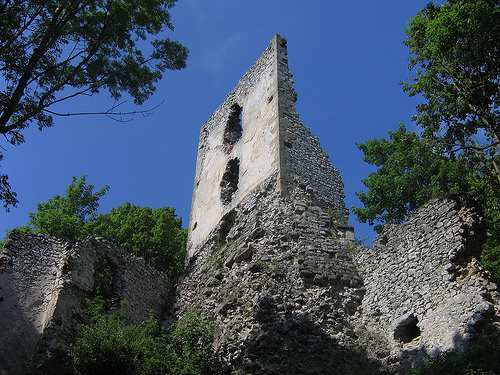

Location: 30 km (19 mi) North of Trnava Map
Dobrá Voda Castle is a medieval citadel situated 30 km (19 mi) North of Trnava in Trnava region in Slovakia. The name of Dobrá Voda fortress means "good water" in Slovakian. It was constructed in the 14th century to protect a strategic high ground overlooking Male Karpaty mountains pass. Much of damage came during Rakoczy Rebellions of Estates. It was finally captured and burned down in the late 18th century. It was abandoned and left in ruins since then. If you like to explore original historic buildings and avoid crowds of tourists this the place to come to.
The castle was built on the site of an older fortified settlement in
the first quarter of the 13th century in mountainous terrain on a rocky
outcrop on one of the roads passing through the ridge of the Little
Carpathians. It is mentioned in writing in 1263.
His location
near the Czech Road predestined him to the role of guard castle. In
ancient times, the castle was an elongated building with a palace that
had quadrangular towers on both narrower sides; another part of the
castle, terminated by a chapel, joined the palace on the southeast side.
The castle, originally in royal ownership, became
the property of Stibor of Stiborice at the end of the 14th century,
later, from 1436 it was already owned by the Országh family.
At
the end of the 16th century, the owners secured the castle with a
pre-gate and rebuilt the lower courtyard, which they supplemented with
several bastions in the castle wall. The castle became less endangered,
because the entrance to the upper castle twisted serpentine and the
lower part was secured by a defense from a higher position.
During the uprising of Francis II. Rákóczi (1703) was badly damaged,
after a subsequent repair in 1762 it burned down and only a prison for
subjects remained on it. At the beginning of the 19th century, like
other castles, it began to turn into ruins.
Today, the castle is in a state of ruin. Part of the masonry with fortifications and the remains of several buildings have been preserved. The process of its destruction is also affected by the amount of greenery, which overgrows the entire building. Nevertheless, its ruins are a picturesque addition to this part of the Lesser Carpathians.